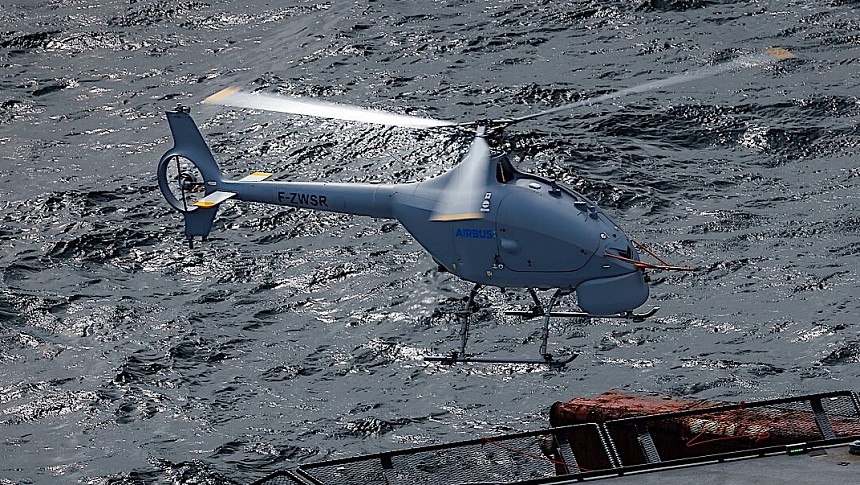We're used to drones being a part of our lives now, but most of the time when drones come to mind they manifest either as small civilian ones used for shooting vacation videos or large, winged ones used for military purposes. But a new breed of autonomous aircraft is slowly making its way into the spotlight: helicopters.
And by helicopters I don't mean regular drones shaped like that, but actual helos converted to fly on their own after taking off in the same manner, and landing pretty much the same way.
Several such projects are in development at the moment, including the Bell 407-based MQ-8C Fire Scout and the VSR700. It's this latter one, originally a Cabri G2 light helicopter, that's of concern to us today.
The drone is being put together by Airbus and the French Armament General Directorate (DGA), and had its first flight in 2019. Yet it was only this week when we got word of it being tested, at sea, in "full operational configuration."
I said at sea because that's the environment the drone is supposed to work over. It can launch from the decks of ships, on its own, go about its recconnaisance business, and come back to land on its own again.
The drone can do the lift-off and landing bits with an accuracy of ten to 20 cm (four to eight inches) thanks to a system called Airbus DeckFinder. We're talking about an independent local positioning system that provides a 3D image of the drone's relative position, "aiding in landing the aerial vehicle safely." It can help the drone leave and come back regardless of wheater or visual conditions.
Last year, the VSR700 performed take-offs and landings in a optionally-piloted configuration from and on an unnamed civilian vessel. This May, however, the drone flew not only fully equipped, but also with a fully autonomous demonstrator – officially called Système de Drone Aérien pour la Marine (SDAM).
The tests, which took place off the coast of Brittany, France, involved the helicopter taking off and landing 80 times. Some of these operations took place in winds above 40 knots (46 mph/74 kph), and they all amounted to eight hours of flying.
When fully operational, the VSR700 will be capable of moving at speeds of 140 mph (220 kph) and carry payloads weighing as much as 220 pounds (100 kg). The diesel engine it's equipped with can keep running for up to ten hours.
Next up for the drone is the start of testing procedures for the second prototype, which will fly for the first time in the second half of the year. It's not clear yet when the VSR700 will achieve operational status and be deployed in service.
Several such projects are in development at the moment, including the Bell 407-based MQ-8C Fire Scout and the VSR700. It's this latter one, originally a Cabri G2 light helicopter, that's of concern to us today.
The drone is being put together by Airbus and the French Armament General Directorate (DGA), and had its first flight in 2019. Yet it was only this week when we got word of it being tested, at sea, in "full operational configuration."
I said at sea because that's the environment the drone is supposed to work over. It can launch from the decks of ships, on its own, go about its recconnaisance business, and come back to land on its own again.
The drone can do the lift-off and landing bits with an accuracy of ten to 20 cm (four to eight inches) thanks to a system called Airbus DeckFinder. We're talking about an independent local positioning system that provides a 3D image of the drone's relative position, "aiding in landing the aerial vehicle safely." It can help the drone leave and come back regardless of wheater or visual conditions.
Last year, the VSR700 performed take-offs and landings in a optionally-piloted configuration from and on an unnamed civilian vessel. This May, however, the drone flew not only fully equipped, but also with a fully autonomous demonstrator – officially called Système de Drone Aérien pour la Marine (SDAM).
The tests, which took place off the coast of Brittany, France, involved the helicopter taking off and landing 80 times. Some of these operations took place in winds above 40 knots (46 mph/74 kph), and they all amounted to eight hours of flying.
When fully operational, the VSR700 will be capable of moving at speeds of 140 mph (220 kph) and carry payloads weighing as much as 220 pounds (100 kg). The diesel engine it's equipped with can keep running for up to ten hours.
Next up for the drone is the start of testing procedures for the second prototype, which will fly for the first time in the second half of the year. It's not clear yet when the VSR700 will achieve operational status and be deployed in service.






